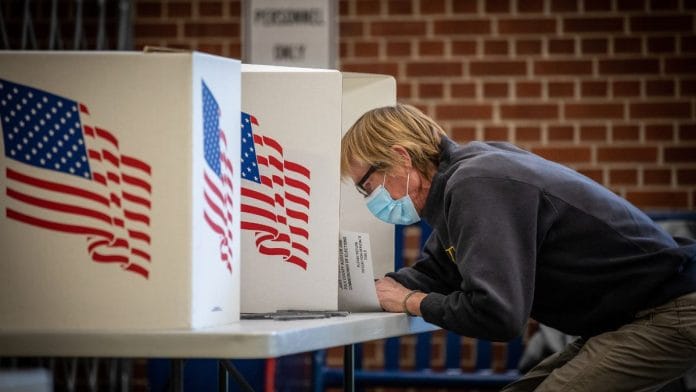New Delhi: As the United States went to the polls for the presidential elections Tuesday, partial data showed that over 82 million, or 51 percent of the people who voted in 2020, have already cast their ballots in advance. When compared with past data, trends show that election day is turning into an election season with more Americans voting in advance.
According to the University of Florida (UF) Election Lab, 82,713,594 early votes had been cast as of 4 November, of which 44,937,426 were in person and 37,776,170 were through mail-in ballots. It also showed that a much higher 67,345,930 mail-in ballots had been requested.
Early voting peaked in 2020 at 69.2 percent of the total voter turnout, or 101,453,111 (101.45 million) votes, though this was in the throes of the pandemic when social distancing norms were being enforced. The year 2020 also saw the highest voter turnout (66 percent) since 1900. Over 158 million people voted in the last election.
Overall, between 1972 (3.7 percent) and 2022 (47 percent), early voting has been trending, according to the UF Election Lab data.
The data comes with certain caveats. Most importantly, a full picture of early voting data and what it means will emerge once the voting period is over and results are announced.
Then, like other aspects of the American election system, rules on permitting early voting and deadlines are all left up to the individual states. Therefore, the data is compiled from states and publicly available sources.
While all states allow absentee ballots, some states require a legitimate reason for the absence, including but not limited to military and overseas voting.
The concept of absentee voting was first introduced during the Civil War so that soldiers could vote from their home states. Federal law requires absentee ballots to be sent to military and overseas voters.
Also Read: Trump or Harris, why US presidential elections matter to India and the world
What it means for 2024 elections
Despite this, a breakdown of the advance voting numbers shows a few things. Nearly an identical number of registered Democrats and Republicans have voted—37.8 and 35.8 percent respectively. This means that the Republicans have caught up on the early voting advantage that the Democrats had earlier. In 2020, for instance, UF Election Lab data shows, 44.8 percent of Democrats had voted early compared to 30.5 percent of Republicans.
According to the Associated Press early election tracker, a record number of early ballots were cast in the battleground states—Arizona, Georgia, Michigan, Nevada, North Carolina, Pennsylvania and Wisconsin. Winning in the swing states, in addition to the red (Republican-leaning) or blue (Democratic-leaning) states, is what gets candidates the electoral votes needed to win an election. According to NPR, “just 44,000 votes in Georgia, Arizona and Wisconsin separated Biden and Trump from a tie in the Electoral College”. And in 2016, nearly 80,000 votes combined in Michigan, Pennsylvania and Wisconsin helped Trump win the presidency.
In Arizona, of the 2,338,279 votes, about 40.8 percent was cast by registered Republicans, Election Lab data shows. In 2020, Biden won Arizona, a first for Democrats since the 1990s, by a margin of just 10,000 votes.
In Georgia, where the Democrats won the last election for the first time since 1992, a record 4 million voters cast early ballots, according to the AP. A breakup of who voted in these states was not available.
However, according to the AP, about 57 percent of all registered voters in North Carolina had cast their votes ahead of Election Day in 2020. This was nearly evenly split between Democrats (32.4 percent) and Republicans (33.3 percent), leading to Trump winning the state in 2020.
However, Harris is polling narrowly ahead, according to a New York Times/Siena College opinion poll released Sunday.
According to the poll, though Harris is narrowly ahead in Georgia, Nevada, North Carolina and Wisconsin, and Trump in Arizona, both are polling within the margin of error in the six states, meaning neither has a clear lead. In Pennsylvania and Michigan, they are tied. According to a CNN projection, based on voting patterns, Harris has about 226 electoral votes while Trump has 219. They will need 41 and 51 more votes, respectively.
Age, gender & race
When divided by age, the highest number of early voters (39.4 percent) are in the 41-65 age bracket, followed by over-65s (34.5 percent). Only 8.6 percent are in the age group 18-25 and 17.5 percent in the 26-40 bracket.
According to a poll conducted by the Harvard Kennedy School of Politics, Harris leads Trump by 60 percent to 32 percent among registered voters under 30. According to an ABC exit poll, voters in the 18-29 and 30-44 age brackets lean Democrat while those aged 45-64 and over-65s lean Republican.
Also, more women (54 percent) voted in early ballots than men (43.6 percent), the Election Lab data showed. Put in context, Harris tends to lead among women and the US abortion row is among the major women’s issues on the ballot this time.
When viewed from a prism of race and ethnicity, White voters made up 64.2 percent of the advance voters, followed by African Americans (22.2 percent), Hispanics (2.7 percent), Asian Americans (1.9 percent), Native Americans (0.5 percent) and others (8.5 percent).
(Edited by Radifah Kabir)
Also Read: No matter who wins this American election, US foreign policy won’t see a dramatic shift






